I can’t remember how I stumbled upon Mario Santamaria‘s collection of blobs and splotches. Shapeless and also probably clueless, the little blimps are representations of the internet as they are drawn in U.S. patents. They made me smile as much as they embarrassed me: do we really know so little about the infrastructures that underlie modern life?

Mario Santamaria, Cloudplexity, 2019
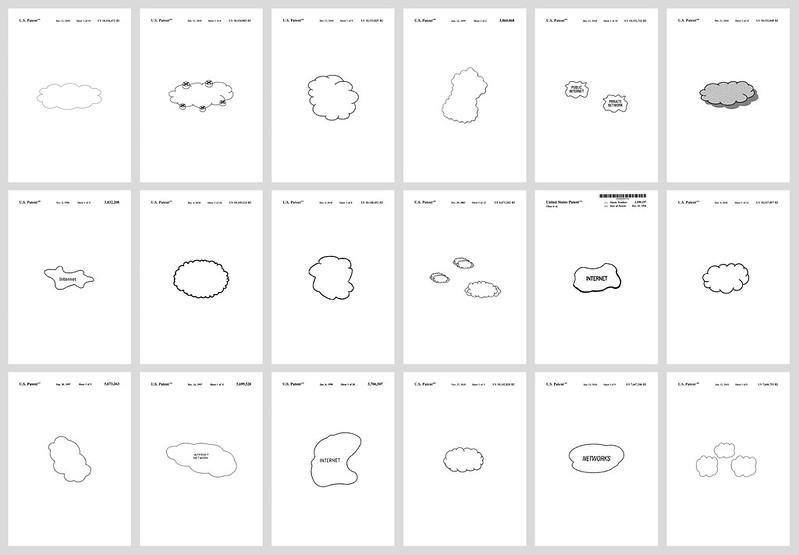
Mario Santamaria, Cloudplexity, 2019
If you click around Santamaria’s website and feel like you’re falling down the rabbit hole, that’s part of his plan. He wants you (and the data) to go to places where you’re not supposed to go. You won’t be entering a strange subterranean universe inhabited by anthropomorphic creatures though but you will learn a lot about the very materiality of the internet.
In 2016, for example, the artist physically traveled to his website. Or rather to the webserver where it is hosted. From his home in Barcelona, it takes a click and a few milliseconds to get access to his data hosted on a server in Bergamo. In real life, as a human being, it took him 14 days to follow the route taken by the data. He started in Barcelona and then went from one ISP point to the next, travelling to Paris, then Switzerland, then Stockholm, Milan, Perugia and, finally, Bergamo. Good thing the server was hosted in Europe and Santamaria has a European passport. He documented the landscapes and buildings along the way and the images are strangely mundane and eye-opening.
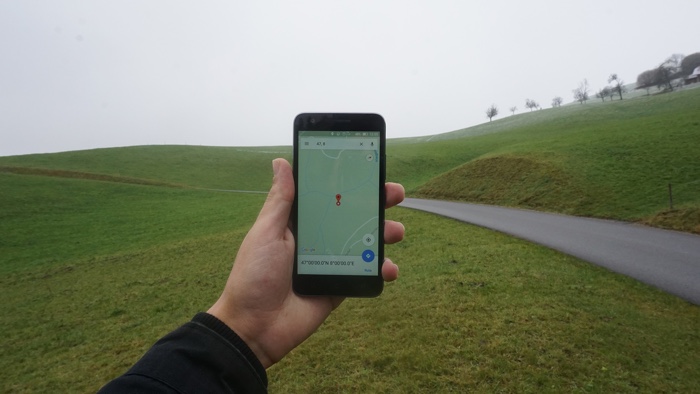
Mario Santamaria, Travel to my Website, 2016
For an exhibition in Barcelona this year, the artist created a router symbolised by the emoji of the rabbit hole, an access point that led data on the most absurd world tour. Using Thor, he made the data packets travel extravagant routes: from Barcelona to South America and back, from Barcelona to Asia to a string of European cities and then back to Barcelona.
Santamaria also shares his own experience and knowledge with other citizens. He sometimes plays the role of the tourist guide, taking sightseers on an Internet bus Tour to visit the data centres, landing areas of fibre optic cables and other anonymous elements of infrastructure that host “the internet” and underpins contemporary life.
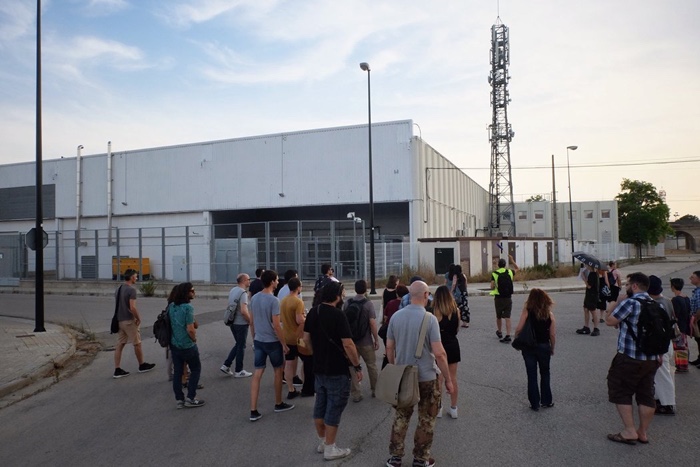
Mario Santamaria, Internet Tour Zaragoza. Photo: Alberto Santamaría
Mario Santamaria graduated in Fine Arts and in the Master Degree in Visual Arts and Multimedia by the Polytechnic University of Valencia. He has done residencies and exhibited his work all over the world and I’m really happy he found a moment to answer my many questions:
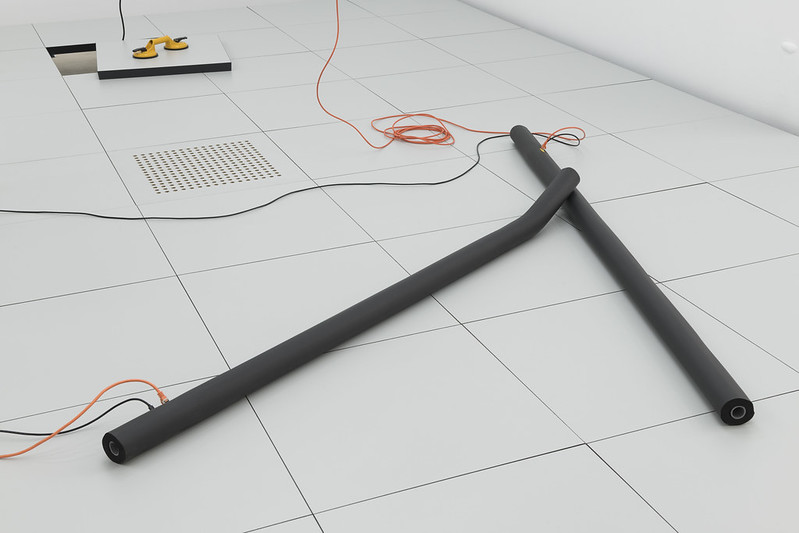
Mario Santamaria, Unfixed Infrastructures and Rabbit Holes. Blueproject Foundation, Barcelona, 2020. Photo: Roberto Ruiz
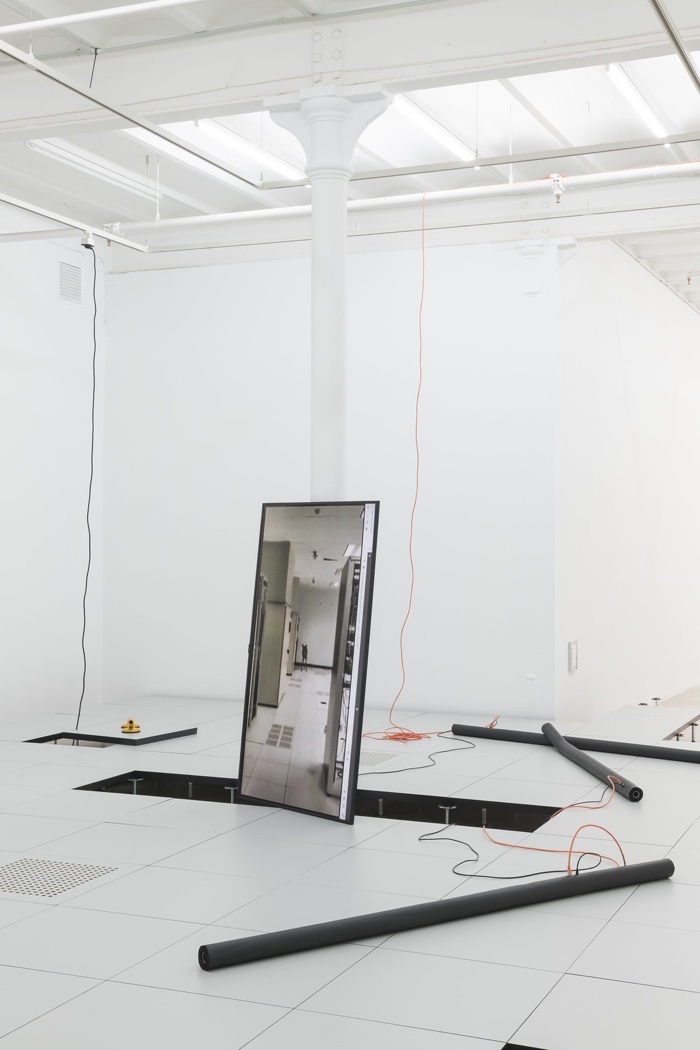
Mario Santamaria, Unfixed Infrastructures and Rabbit Holes. Blueproject Foundation, Barcelona, 2020. Photo: Roberto Ruiz
Hi Mario! Cloudplexity is one of my favourite works of 2019. It’s smart, simple and tells so much about our inadequacy of picturing “the cloud” or even “the internet”. If I understood correctly, your research started with patents dating back to 1998 and continued until the 2018 patents. Did you observe any change in how the internet was pictured over these past 20 years? Has it become even foggier over time for example? Or have we always been totally clueless?
The series starts in 1990 and ends in 2018. I search in patent registries for internet representations in the form of diagrams or drawings. Then I remove the elements that do not interest me, and I focus on the representation of the Internet. I keep the same format, reference numbers, year and registration. Within the United States archive, the first representation I have found of something similar to the Internet as a cloud form is the Defense Data Network (DDN) in January 1990, the DDN was a separate military network from ARPANET. A fog inside the cloud.
The clouds have multiplied inside the space of representation. The Internet is a cloud, but so is Facebook, Google or Instagram. It seems that as objects become more technical their representation becomes blurred, changing their position in the human field of vision. They become data extraction spaces and connective nodes. Vacuum cleaners, bracelets, telephones, refrigerators are also clouds, their operational representation as an appliance exceeds their utilitarian capabilities in relation to the user. Behind our backs, part of their image remains in a blind spot, outside our ocular capacities. This confusion is tackled by late capitalism and its “intellectual property” when it tries to recognize and record every emerging form. It does so in the cloudiness, before it becomes visible and this is a task increasingly destined for machines rather than humans.
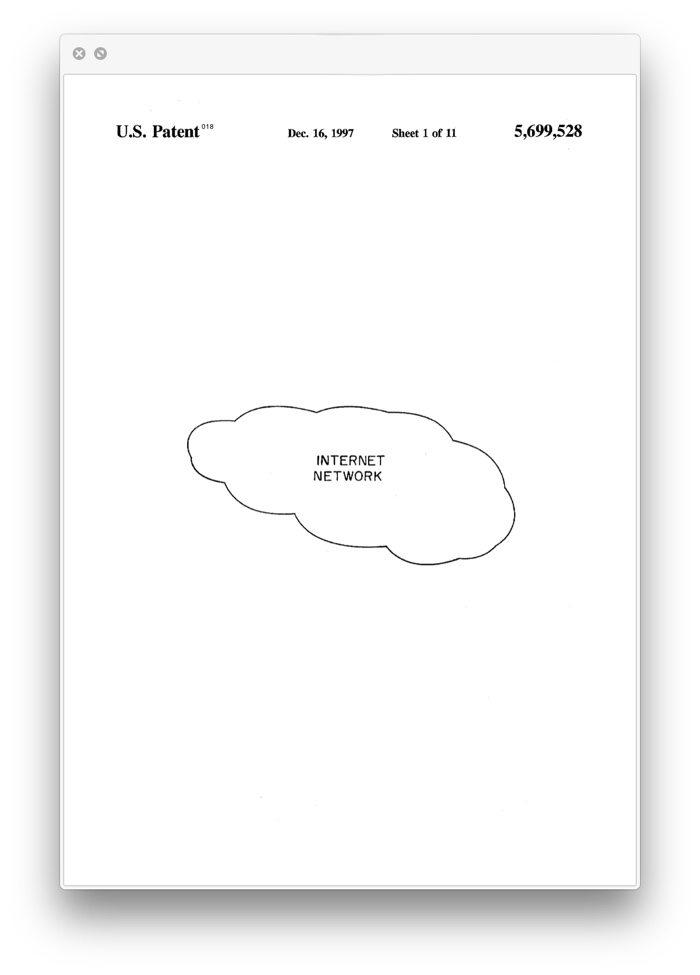
Mario Santamaria, Cloudplexity, 2019
Is this a specific type of patent that represents the internet as a transparent blob? A patent for a service or product that doesn’t have digital technology at its core for example?
In a way, yes, it seems to be a resource to delimit an area in which different things are inscribed. But also to represent something that we do not fully understand or establish its limits. Does the concept of cloud have limits or borders?
I like this Antonio da Correggio’s painting “Jupiter and Io” (c. 1530), in the myth, Jupiter becomes a cloud so he can sleep with the nymph Io.
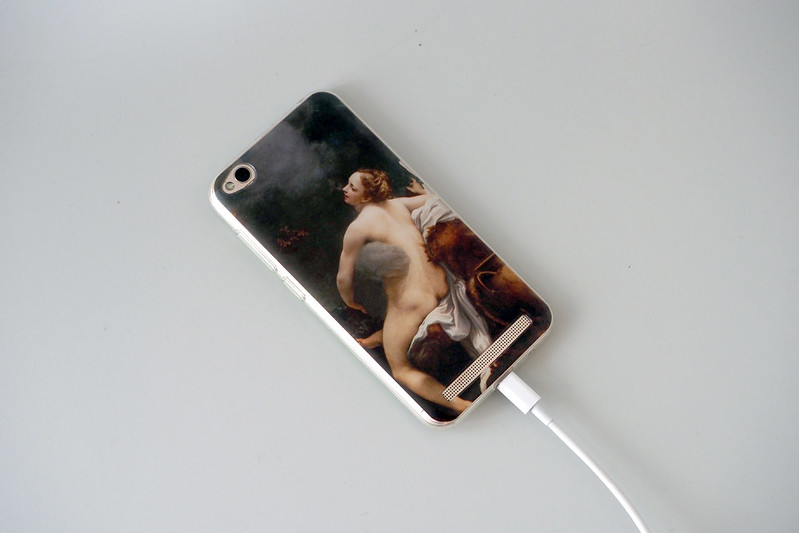
Mario Santamaría, Jupiter, Io and smartphone, 2019
I’m also curious about the Internet Tours you organised in several cities across Spain. You did one in Madrid and the other in Zaragoza. Since much of the infrastructure that enables our always-on digital culture is anonymised, located outside of city centres or downright hidden from public scrutiny, how did you find about them? What is the research process I should adopt if I wanted to know about internet infrastructure in my own city?
I have made numerous Internet Tours in Madrid (2018), Barcelona(2018, 2020), Bilbao (2020) and Zaragoza (2019). Also in workshop format with students in Italy (http://internetour.com/ISIA/) where different groups of students have made their versions of Internet Tours in several Italian cities: Urbino, Bologna, Verona or Palermo.
We also made a video tutorial with sonar+d where we explained how to create your own tour. Only in Spanish sorry.
As you know Barcelona was a popular tourist destination, the idea is to pervert the tourist act of the bus and re-appropriate the experience of collective exploration. Our body is part of a network of tele-technologies settled on the territory. Surfing the internet is a speleological practice, from the house to the cave and from the bunker to the data center.
In the Internet Tourist Bus where we can route together, move like a data packet from node to node. The Explorer’s metaphor in your own city, visiting industrial parks, spaces between roads and concrete buildings.
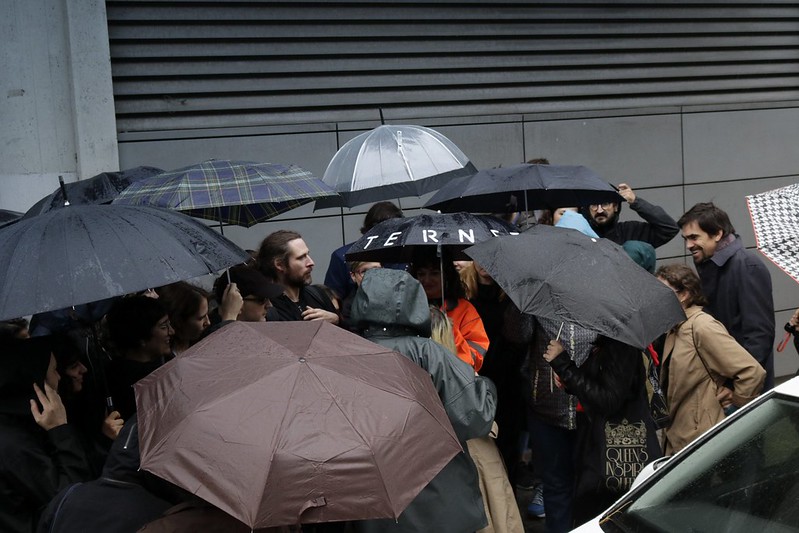
Internet Tour, Barcelona 2018. The Influencers Festival, CCCB. Photo by Carlos Monroy/The Influencers
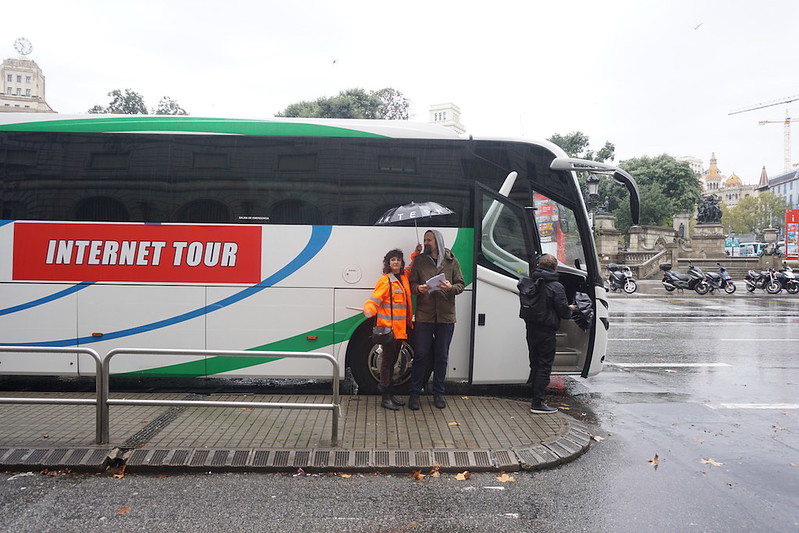
Mario Santamaria, Internet Tour, Barcelona 2018. The Influencers Festival, CCCB
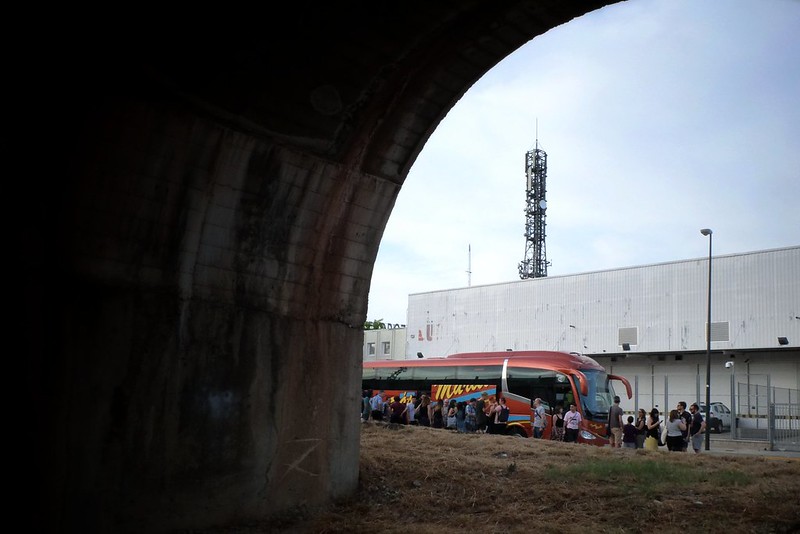
Mario Santamaria, Internet Tour, Zaragoza 2019. Etopia Art and Technology Centre
One thing I keep reading about internet infrastructure is that they rely on a colonialist heritage. The undersea cables, for example, following the old trading & communication routes from European countries and their former colonies. Is this something you observed in Spain? And is it still roughly the case or are geopolitics shifting?
Of course, you can see the relationship with that colonial past. For example, the large construction companies of public works are those that deploy more fiber optics and we can see how Spanish companies develop public works (trains, roads) in countries that were formerly Spanish colonies.
For me, the history of the Internet is a process of synchronization of the world and the construction of the transatlantic telegraphic cable in the second half of the 19th century is a determining moment. It meant a revolution when it came to establishing the exchange rate between different currencies such as the pound and the dollar. The Internet is a process of synchronization that integrates different devices, concepts and infrastructures.
A few days ago, we went for a picnic to Playa del Litoral, Barcelona with friends and students where AFR-IX telecom is carrying out the works of the first phase to connect the 2Africa cable, with 37,000 km in length, it will be one of the largest submarine cable projects in the world and it will interconnect Europe (to the east through Egypt), the Middle East (through Saudi Arabia) and 21 landings in 16 countries in Africa.
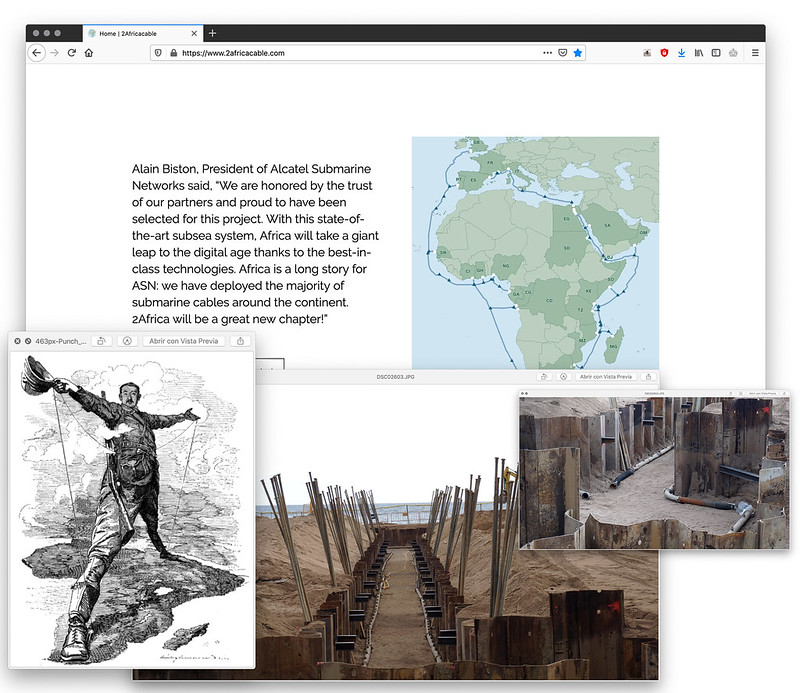
Photo courtesy of Mario Santamaria
Since you did a tour of both Madrid and Zaragoza, I’ve been wondering what makes these two cities interesting for any citizen who wants to understand internet physical infrastructure. Madrid is the capital of the country so I’m not surprised to read it has many data centres but how about Zaragoza? Why that city in particular? What makes it a good place to explore internet infrastructure? Does this city of less than a million inhabitants play a particular role in Spain?
The idea of Internet Tour is to create a common tactic that can be developed in very different places and contexts. Each region has its peculiarities and that uniqueness in relation to the infrastructure is explored in the tours. It is also an open model, do some research and organize a tour for friends and strangers into and through the Internet in your city.
Zaragoza is the 5th city of the Spanish state by population and traditionally an important military and merchandise node in the north of the Iberian Peninsula, and this has to have some relation to the fact that Amazon Web Services (AWS) has plans for the construction of three centers in this region. In each city, research is being done on its infrastructure and its relationship with communication technologies.
In Madrid we proposed to go around the capital, a circle, from ISP to ISP, playing with the idea of being a packet of data without TTL, gravitating eternally without destination around the city.
In Barcelona, the route was structured around the coast, the relationship with the port, the sea, the climate crisis and fragility.
In Zaragoza, a gas company operates that uses the infrastructure of the gas ducts to install optical fiber, this relationship between the gas and the optical fiber served us to articulate a route from the copper stations in dismantling and the transformation of part of the infrastructure in something increasingly light, ubiquitous and volatile.
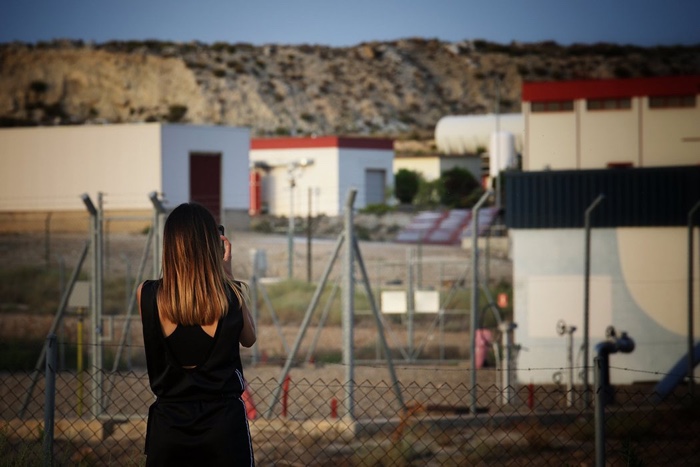
Mario Santamaria, Internet Tour Zaragoza. Photo: Alberto Santamaría
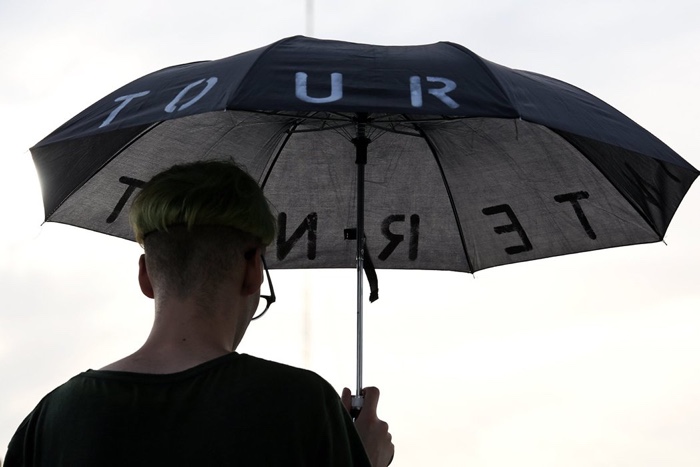
Mario Santamaria, Internet Tour Zaragoza. Photo: Alberto Santamaría
I read in El Cultural that you had physically travelled from Barcelona to the place in Bergamo, Italy, where your webpage is hosted. You followed the same route as the network packets, stopping at every internet service provider point. This took you to Paris, Stockholm, Perugia, etc. You did that physical trip, really? In 14 days? Can you tell us about the odyssey? How close can you get to the locations where the data transits and hops from one isp to another?
My intention is not to investigate the way data travels, it is to move like them. To incarnate, to embody a process that is algorithmic, to get into my “trace body”. In 2016 I carried out the artistic project Travel To My Website which consisted of a journey from my home in Barcelona to the server where my personal website is hosted in Bergamo, Italy. This action imitated the same route that data takes through the internet infrastructure. The planning of the trip was created by means of a computer diagnostic tool, about data traffic, called Traceroute. This tool provides a list of IP addresses, usually corresponding to geographical locations. The Traceroute also shows us the times it has taken the information to move from one point to another. In 67 milliseconds the data on my website left Bergamo, heading for Perugia, Milan, Stockholm, Switzerland until it reached Barcelona. Traveling to my website was the opposite: I decided to travel to these places with the aim of moving as a data package. This action proposed the embodiment of an algorithmic procedure (TCP/IP protocol) and at the same time materialised the temporality in which the body of data moves.
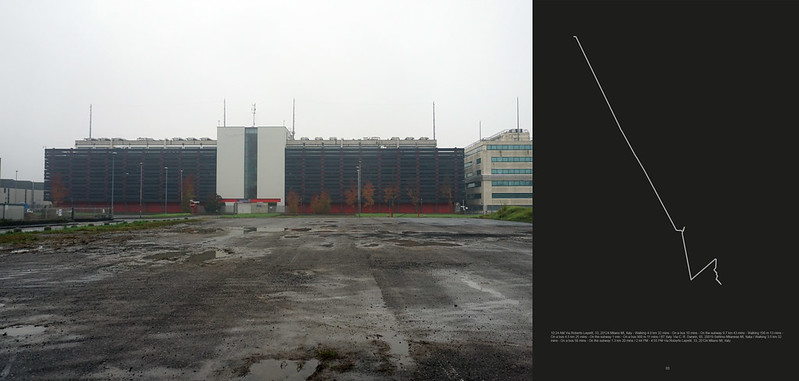
Mario Santamaria, Node 04. BT Group Building, Milan, Italy / Daily geolocations. Travel To My Website, 2016
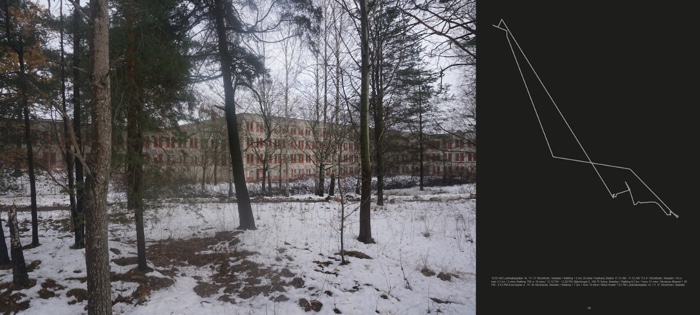
Mario Santamaria, Node 02. Telia Company AB Building, Stockholm, Sweden / Daily geolocations. Travel To My Website, 2016
Three years later, I presented the online version for the Arebyte gallery in London. On this occasion, I decided to create a web page that compiles all the graphic material of the experience of the journey made in 2016, such as photographic captures of the nodes (data centres), the places where I stayed, the objects that accompanied me, the views from the means of transport, maps and recommended routes, wifi passwords and travel notes. The way of showing this file meant a trip back to the computer landscape. If in Travel To My Website (2016) it is the human body that adopts a mechanical temporality and moves like a data package, here it is a computer procedure, the Traceroute, that processes a human temporality. In such a way that the web is a navigational device that works with the same contradictions that came about during the journey and at the same time tells us about our relationship with tele-communication technologies.
It is a website that takes as long to load and view the files of each stage of the journey (telecommunication node) as it did the stage of my offline journey. Therefore, to download the images of my first day in Milan, the user must remain with the browser open for 4 days.
And, it is in this relationship of the user with the web that we propose an alteration of the codes and conventions that we establish with the online interfaces. The proposal (re)locates the phenomenon of the observer, shows his or her regime of visibility, their meetings and expectations, the horizon of expectations and tells us about an out-of-time and dysfunctional journey that unfolds 67 milliseconds in 14 days.
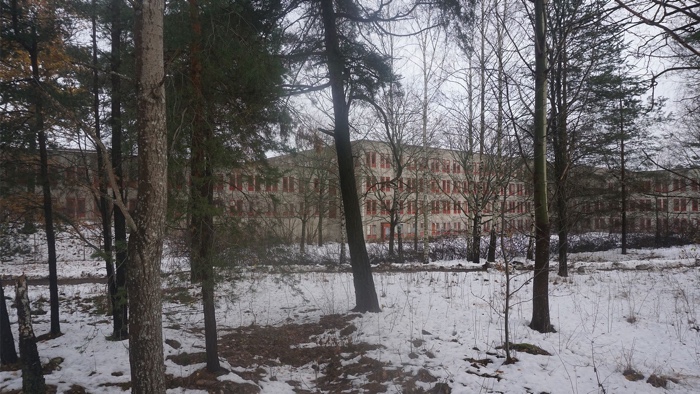
Mario Santamaria, Travel to my Website, 2016
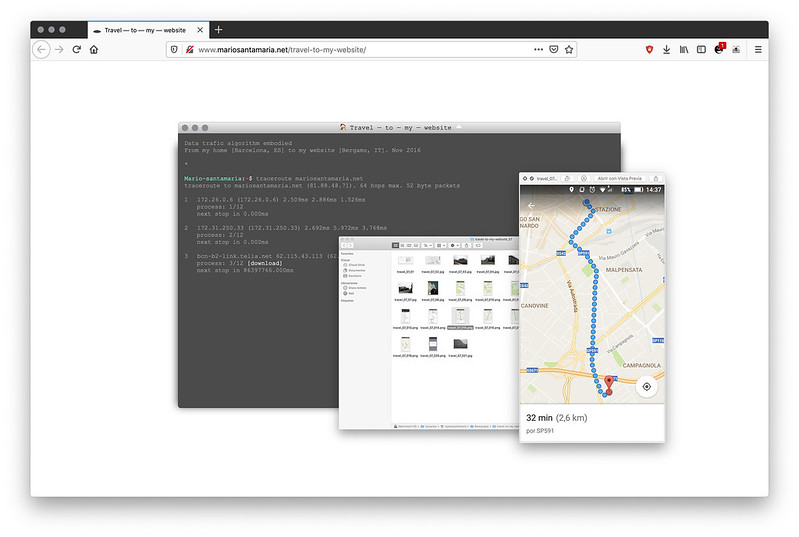
Mario Santamaria, Travel to my Website, 2016
I’m very intrigued by a project you developed at the Hangar Interaction Lab. It “consists of the development and prototyping of a series of artefacts-routers that establish other forms of network connectivity.” Can you tell us more about it? Is there already something we can see / read online about this research?
The objective is to create speculative connective objects, in the first prototypes I work with the TOR network to redistribute the traffic geographically, altering the routing protocols used “tunnels”. Moving through the Internet infrastructure under parameters that are not those of efficiency, thinking in sculptural terms, the flow of materialities activated in a telematic process. The relationship between different temporalities, objects, geography and body.
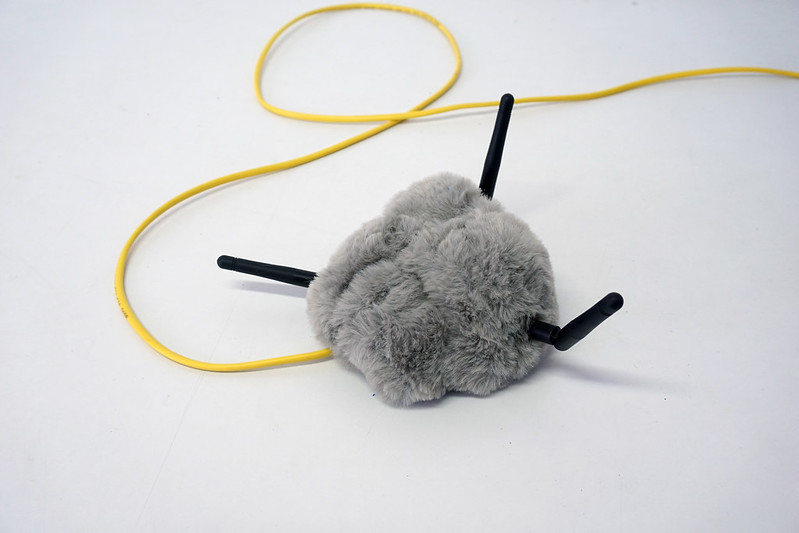
Mario Santamaria, Caress Router, 2019
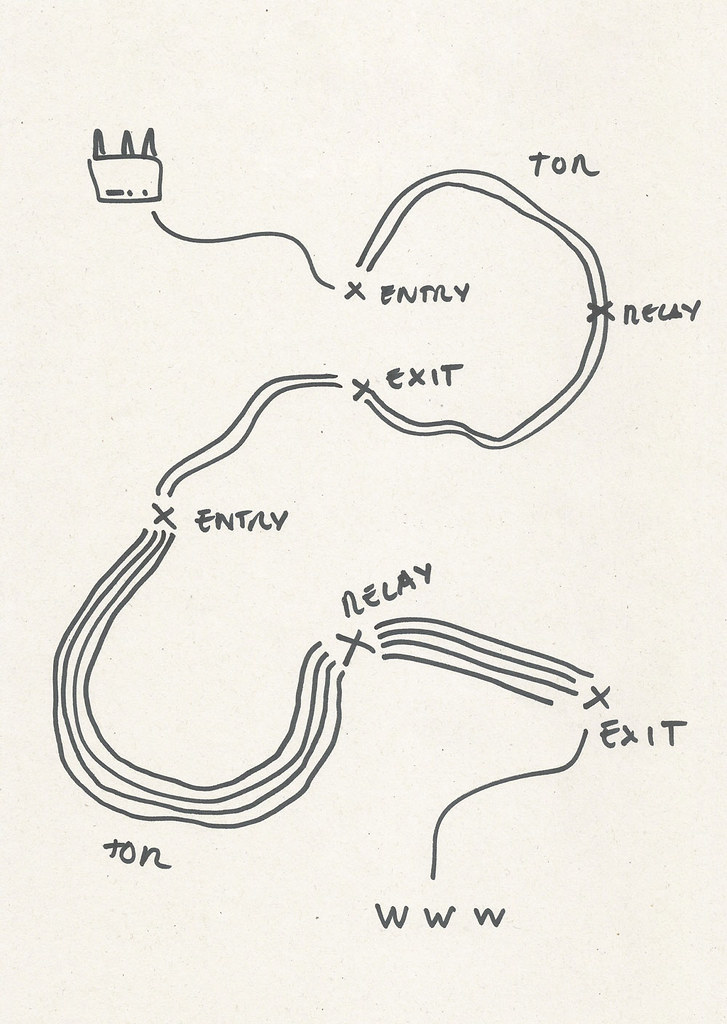
Mario Santamaria, Speculative Networks, 2019
In 2016 we organised a workshop in MediaLab Prado Madrid that aimed to leave a data packet floating eternally on the Internet by altering the TTL protocol. To turn unexceeded time into inexhaustible time. Since then, I have been developing, in collaboration with Hangar and Andrea Noni, we have developed several prototypes using the TOR network possibilities. The latest has been shown in the exhibition Unfixed Infrastructures And Rabbit Holes where the main element of the exhibition is a router that connects us to the internet so that the data has to travel through the infrastructure as long as possible looking for the limits of the network protocols. We have managed to test 40,000ms of latency in this network that we have created. And we represent it as a rabbit hole:
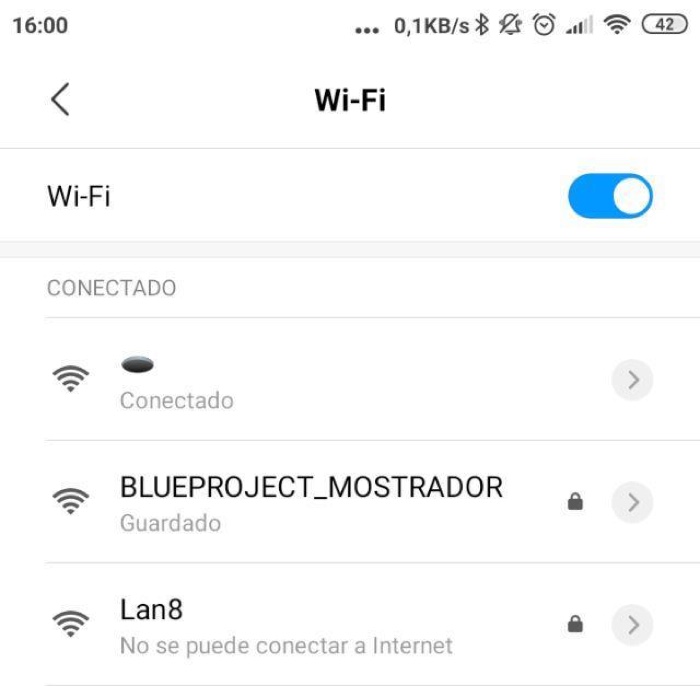
Mario Santamaria, Unfixed Infrastructures And Rabbit Holes, 2020
Show Me a Ghost is a very curious and interesting work as well. The photo project reveals the difficulty for computer vision system to detect the representation of a ghost. How did you discover that fact? And how do you explain it in the context of a technology and a society so focused on images?
I found that within the structure of the image.net file there is no category of ghost, that is, there is no training dataset to define what shape or appearance it has. I found it interesting and decided to create a dataset of ghost images and try in an absurd way to train the facebook algorithm to recognize ghosts in images. A kind of symbolic action on the gaps of technological development formalised as if it were a photo book without images.
The series shows how a computer vision system interprets the representation of a ghost, an element that does not appear in the categories of “ImageNet” and is so far undetectable in the eyes of the algorithm.
The aim of the project was to address the spectral issue in computational photography if in analogue photography the phantom operated by a superposition of time and captures, in computational photography the disturbance does not come from its representation. The phantom is in the black box, in that full moon that we all photograph with the same result.
Mario Santamaria, Show Me A Ghost, 2017
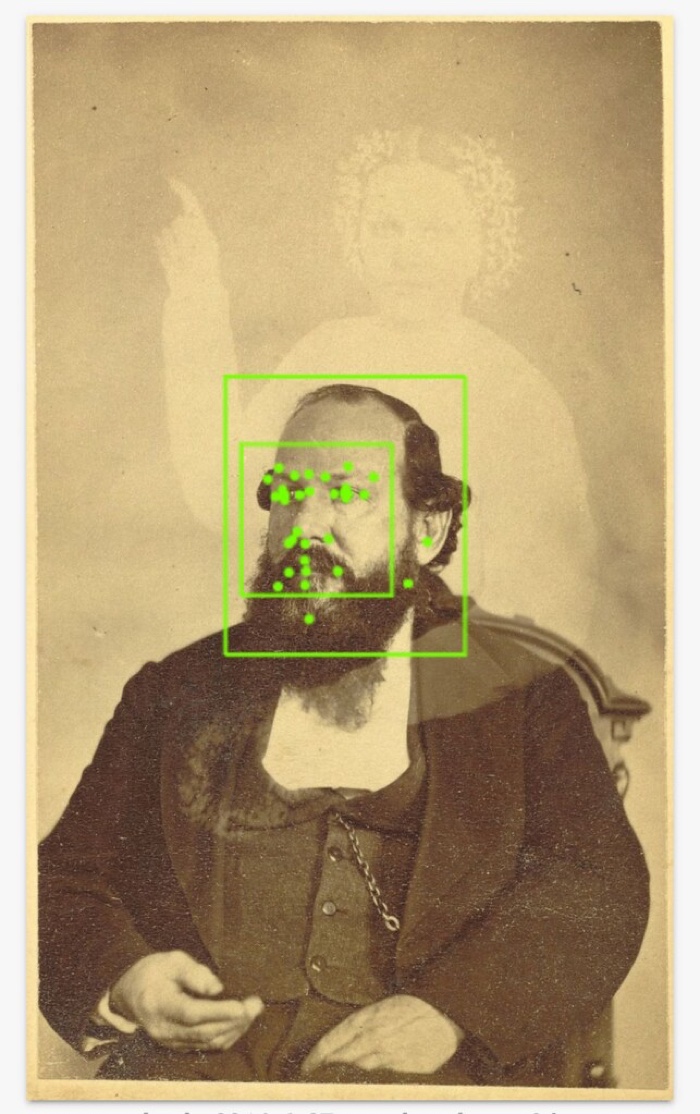
Mario Santamaria, Show Me a Ghost, William H. Mumler, 2017
Thanks Mario!
One of Mario Santamaria‘s works The Phantom of the Mirror. Trolling Google Art Project is currently on view at ZKM Karlsruhe as part of Writing the History of the Future – The ZKM Collection, curated by Peter Weibel and Margit Rosen.
Related stories: A guided tour of Dublin’s physical Internet infrastructure; Critical investigation into the politics of the interface. An interview with Joana Moll; Critical Exploits. Interrogating Infrastructure, etc.
